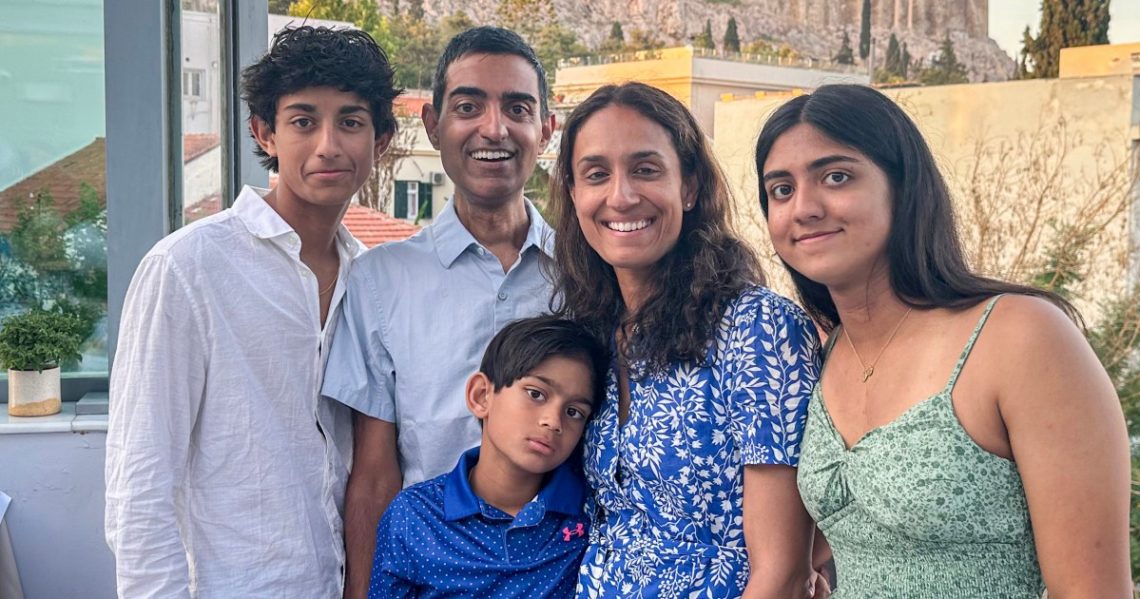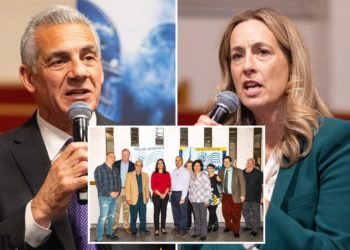Dr. Rakesh Parekh was in his mid-40s when he first noticed something was wrong: During his workouts, his left arm was weaker and struggled to keep up. Initially, Parekh, an emergency medicine doctor and father of three, assumed he was overdoing it in the gym.
“There was no part of me that wanted to believe that was in jeopardy,” said Parekh, 52, of Orlando, Florida.
Parekh had watched his father die of amyotrophic lateral sclerosis, the progressive neurological disease commonly known as ALS or Lou Gehrig’s disease. In 2021, a neurologist confirmed what Parekh feared: he had the same incurable diagnosis.
“I really didn’t think that there was something out there that could prolong my life or improve my life,” Parekh said.
That wasn’t the case. A genetic test told Parekh’s doctors that his disease was caused by a mutation on a gene called CHCHD10, information that his father wouldn’t have had just a decade prior. Though exceptionally rare, CHCHD10 is one of the roughly 40 genes that scientists have identified as the cause of about 20% of ALS cases.
In April 2024, Parekh got a personalized drug called an antisense oligonucleotide, or ASO. His treatment was tailormade by the n-Lorem Foundation, a nonprofit that makes individualized treatments for patients with extremely rare diseases that are caused by single gene mutations. Dubbed “nano-rare” diseases, they affect fewer than 30 people at a time, according to the group’s founder, chairman and CEO, Dr. Stanley Crooke.
Crooke said he started the nonprofit because patients with nano-rare diseases “have no hope, no place to go, no help.” Because the diseases are so rare, there’s no commercial value in developing drugs for them, he said.
“That’s why we exist, to fill that void,” Crooke said. The foundation pays for the entire cost of developing the drugs, which can take several years.
Parekh’s treatment from n-Lorem was the first ever to target CHCHD10 mutations in someone with ALS.
ALS is caused by faulty proteins that attack neurons in the brainstem and spinal cord, eventually causing a person to lose muscle control, including those needed to breathe. ASOs target the mutated genes that make these proteins, halting their production. The gene isn’t altered but, by silencing it, it should prevent the disease from rapidly progressing.
With any ALS intervention, the key is catching it early, before a significant number of neurons have died, said Dr. Jeffrey Rothstein, director of the Robert Packard Center for ALS Research at Johns Hopkins Medicine. “When we see some patients, these cells are sick but not dead. So by turning off these genes, they can get some of this strength back.”
In Parekh’s case, the targeted therapy appears to have slowed the progression by more than half.
“His disease has maybe even improved a little bit, he is not losing strength like he used to,” said Dr. Bjorn Oskarsson, Parekh’s neurologist and the director of the ALS Center of Excellence at Mayo Clinic Fordham in Florida.
That’s not typical news for someone four years into an ALS diagnosis.
“By the time people have symptoms that worry them enough to go see a neurologist and they are diagnosed with ALS, they typically only have about three years,” said Brian Pierchala, a professor of ALS research at Indiana University.
Targeting genes
ALS has historically been an extremely difficult disease to treat. There is still no cure and the disease is always fatal.
ALS does not have one single cause, which makes targeting the origin of the disease particularly challenging. Genetic mutations are a smoking gun — as long as scientists know which ones to look for.
“When you turn off the gene, you put out the match that starts the fire,” Rothstein said.
About 10% of people have familial ALS, which is genetic and passed down. The remaining 90% have sporadic ALS, which isn’t inherited. Among people with familial ALS, 70% have a known genetic mutation, according to the ALS Association. Among people with sporadic ALS, that number drops down to around 10%.
Not all ALS is caused by genetic mutations, but every year, geneticists identify more mutations that are linked to the disease. As the list grows, Oskarsson expects inherited genes — which can open the door to more targeted treatments — to explain more than half of all ALS diagnoses.
“Our success rates are much higher if we try to tailor therapies for individuals who carry [a] particular genetic mutation,” said Dr. Suma Babu, co-director of the Neurological Clinical Research Institute at Massachusetts General Hospital. “For a long time we only had one medication that only extended life by three to 12 months.”
Babu said the field is rapidly evolving.
The Food and Drug Administration has approved four ALS drugs since 1995, most recently, an ASO called Qalsody from drugmaker Ionis Pharmaceuticals — a company founded by Crooke before he left and started the n-Lorem Foundation. It was the first FDA-approved ALS drug that targeted a genetic mutation, called SOD1. This type of ALS accounts for about 2% of cases in the U.S., or roughly 500 people.
“It’s a small number of people, but it’s a potentially very powerful drug for a disease that otherwise does not have a treatment,” Rothstein said.
Studies have shown that the drug can slow disease progression and even improve symptoms — the same response Parekh appears to be having to his personalized treatment.
“That has paved the way for these more precision medications that target some specific genes in ALS,” Babu said.
ALS experts and specialized centers are now partnering with nonprofits like the n-Lorem Foundation and Silence ALS to expand ASOs to more people as more mutations are discovered. This is a big step forward in ALS treatment, but gene-targeting therapies are limited in who they can help.
“We know gene mutations right now for 15–20% of patients, so that leaves about 80% of people without known gene mutations,” Pierchala said. ASOs also haven’t been developed for all known genetic causes of ALS, he added, since different genes behave in different ways, making some more difficult to target.
Unlocking future treatments
Parekh’s personalized treatment took three years and $1.2 million to create, but now that it’s been made, creating a drug for other people with a mutation on the same gene will be much quicker.
Crooke, of the n-Lorem Foundation, said there are now around 10 people that the nonprofit is treating using Parekh’s drug as a starting point. The foundation covers all of the costs of the drugs.
Parekh has been getting the drug for over a year, longer than his father lived after his diagnosis. Every three months, he gets a spinal tap, where the treatment is injected directly into his cerebrospinal fluid.
He’s still able to play with his kids and recently got back from a trip to Greece, where he was able to climb a steep set of stairs to the Acropolis. Because the treatment is so new, it’s unclear how durable the effects will be.
“We don’t have decades of experience with it. We are hopeful that it will hold for their lifetime, but we do not know that,” Oskarsson said.
As more people get them, and as geneticists uncover more genes linked to the disease, ASOs “will be transformative for certain subtypes of ALS,” Babu said, even if the gains made with each gene can’t help everyone.
“If we can make this a livable disease for 300 people who are potentially in the prime ages of their lives, I think that’s success,” she said. “If we can chip away gene by gene, subtype by subtype, I think we will see successes in ALS.”
The post A tailormade drug slowed a man’s ALS. Is it the future of treatment? appeared first on NBC News.




